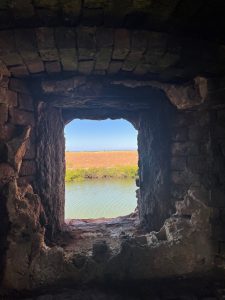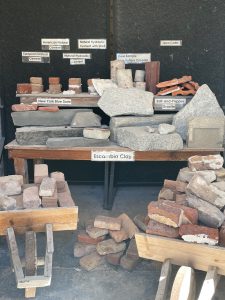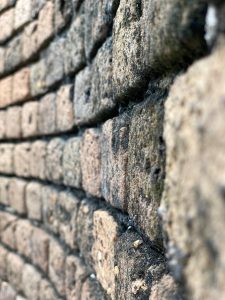
It looks just like Fort Pickens. The arches, the bricks, the cannons, the individual rooms–until you look out the windows and see tropical vegetation and water adjacent to the walls. These photos were not taken on Pensacola Beach, but at Fort Zachary Taylor in Key West. These American fortresses, exhibiting the same standard protocol for federal protection of crucial waterways, began construction within a decade of each other, in the 1830’s and 1840’s. The bricks for both forts—along with the largest brick structure in the United States, the Dry Tortugas’ Fort Jefferson—were mined and manufactured right here in Pensacola.

Why here? The combination of mud, clay, and rich organic material flowing down the Escambia River eventually settled out at the mouth of the river, creating thick layers of clay. These clay deposits—dating way back to the Pliocene and Pleistocene eras (Florida Geological Survey, Annual Report, Volume 15)—built up the bluffs on Escambia Bay, along what is now Scenic Highway . This red clay soil was ideal for brickmaking, and beginning in the late 1700’s, multiple operations started up along Escambia bay’s bluffs. Several brick-making family names are still recognizable in modern residents and street names today, including Noriega, Gonzalez, and Yniestra. Interestingly, one of the largest of those Pensacola brick factories was woman-owned. Mariana Bonifay (1760-1829) utilized her status as a widow to own and sell property and businesses, including an incredibly profitable brickyard on Escambia Bay. A fascinating and independent woman, she had at least 10 (some records say 14) children and refrained from marriage to the father of several of her children to maintain her legal status as business owner.

After the Spanish officially transferred ownership of Florida to the United States in 1821, the Army Corps of Engineers took notice of this burgeoning brick industry in Pensacola. When military fort construction required millions of bricks, (Fort Jefferson alone is built of 16 million!), several enterprising individuals realized there was a small fortune to be made in government contracts. Hand-making bricks and shipping the heavy cargo all the way down to the Florida Keys proved to be a difficult and time-consuming process. The businessmen, Phillip Raiford and Anderson Abercrombie, who contracted for manufacture and delivery of the bricks for the forts got ahead of themselves. They delivered fewer bricks than promised, late, and of unstable composition for the intense construction job. Demand was so high and the process so tedious, however, that they were given several chances to get it right. After years of trial and error and even the invention of a mechanized brick-making process, multiple orders of hundreds of thousands of bricks made their way by ship to south Florida. By 1860, the company (now Bacon & Abercrombie) was churning out 8 million bricks a year as the largest brick manufacturer in the state.

The brick masons at Fort Zachary Taylor were recent immigrants to the United States, of Irish descent. However, it was through slave labor that most of the backbreaking brick manufacturing was conducted. NAS Pensacola leased enslaved persons from local residents for their skilled craftsmanship, and these men constructed Fort Pickens. At least 20% of the workforce at Fort Jefferson was composed of enslaved African Americans, as well. While not given equal pay or respect at the time, the descendants of these talented men can be quite proud of their ancestors’ incredible effort. Fort Pickens, Fort Taylor, and Fort Jefferson are engineering marvels, standing tall despite 200 years of intense sunlight, saltwater, and high-velocity hurricanes. If you visit any of these forts, each one of those bricks tells an extraordinary story of water, soil, hard work, and innovation. And those stories began right in our backyard.
 0
0
